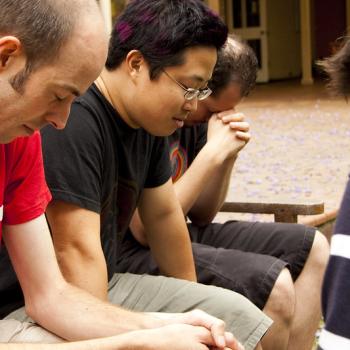The engagement between science and faith may be analogous to Greco-Roman wrestling; two very strong entities grapple, resist, hold, and release but remain mostly bound in an intricate dance that is both unsettling and beautiful. Similarly matched in strength, both straddling the same foundation of awestruck inquiry, the "victor" in one match can easily be the vanquished in the next.
All of this makes the upcoming release of Andrew Parker's The Genesis Enigma: Why the Bible Is Scientifically Accurate, of keen interest to those following the debate on our beginnings. A synopsis from a piece in The UK Daily Mail sounds enticing:
The revalation [sic] came to Professor Andrew Parker during a visit to Rome. He was in the Sistine Chapel, gazing up at Michelangelo's awesome ceiling paintings, when a realisation struck him with dizzying force.
‘A Biblical enigma exists that is on the one hand so cryptic it has remained camouflaged for millennia, and on the other so obvious one cannot miss it.'
The enigma is that the order of Creation as described in the Book of Genesis, and so powerfully depicted in the Sistine Chapel by the greatest artist of the Renaissance, has been precisely, eerily confirmed by modern evolutionary science.
Parker's thinking is fascinating as it breaks new ground:
On the fourth day, Genesis famously becomes confusing. On the first day, remember, God has already created light, and made Day and Night. But it isn't until day four that he makes the lights in heaven, the greater light to rule the day and the lesser the night.
Hang on -- so he made ‘Day' three days before he made the Sun? . . .
Yet the writers of Genesis were just as well aware as us, surely, that the sunrise causes the day. You don't need a degree in astronomy to work that one out. What on earth did they mean?
Here, TheGenesis Enigma comes up with a stunningly ingenious answer. For Parker argues that day four refers to the evolution of vision. Until the first creatures on earth evolved eyes, in a sense, the sun and moon didn't exist. There was no creature on earth to see them, nor the light they cast.
When Genesis says: ‘Let there be lights . . . To divide the day from the night,' it is talking about eyes. "The very first eye on earth effectively turned on the lights for animal behaviour," writes Professor Parker, "and consequently for further rapid evolution."
Emphasis mine. Intriguing, no?
Created creatures continually evolve; from conception to death, life is an evolutionary proposition that argues for itself with every new insight, and that makes a grave case against unnatural endings, for as each age perceives scientific advances as happening with alacrity, our understanding unfolds slowly, imperceptibly, amid living, progressing humanity.
Michelangelo's Sistine Chapel is many things to many people -- a study project to an atheist student, a dream (or nightmare) assignment to a photographer, an illustrated Bible to the believer. It is also a kind of evolutionary marker in the Grand Quest, as depicted in the reach between Creator and Creature -- the chasm of knowledge and wisdom between them -- and in the mysterious vibration of pre-destiny that moves in sync with our every discovery and prayer.
"Let there be light." Then there is fire. Then there is the wheel. Then there is a canoe, then there is a coach. Then there are great buildings, monuments, and designs as humanity dreams and tinkers. Leonardo studies birds and flight, fish and underwater travel; Benjamin Franklin creates primitive flippers and flies kites in the rain, and before and after them humans direct the Divine Spark within toward things as mundane as wire hangers and as fantastic as a laser. In failure or success, they evolve; enigmata unfold before them, and with them, toward . . . what, exactly?
From the mind of Michelangelo comes staggering vision applied one paint stroke at a time, and as he dabs at the stone, even he cannot dream that 600 years later, in a world where mankind considers walking on the moon to be "old stuff," a scientist will ponder this work and discover within it another clue -- another way of applying all we do know to that which we do not understand -- thus angling Adam's outstretched, tentative hand just the tiniest bit nearer to God's.





